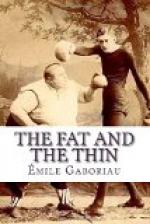The deep-lying forests of seaweed, in which the mysterious life of the ocean slumbers, seemed at one haul of the nets to have yielded up all they contained. There were cod, keeling, whiting, flounders, plaice, dabs, and other sorts of common fish of a dingy grey with whitish splotches; there were conger-eels, huge serpent-like creatures, with small black eyes and muddy, bluish skins, so slimy that they still seemed to be gliding along, yet alive. There were broad flat skate with pale undersides edged with a soft red, and superb backs bumpy with vertebrae, and marbled down to the tautly stretched ribs of their fins with splotches of cinnabar, intersected by streaks of the tint of Florentine bronze—a dark medley of colour suggestive of the hues of a toad or some poisonous flower. Then, too, there were hideous dog-fish, with round heads, widely-gaping mouths like those of Chinese idols, and short fins like bats’ wings; fit monsters to keep yelping guard over the treasures of the ocean grottoes. And next came the finer fish, displayed singly on the osier trays; salmon that gleamed like chased silver, every scale seemingly outlined by a graving-tool on a polished metal surface; mullet with larger scales and coarser markings; large turbot and huge brill with firm flesh white like curdled milk; tunny-fish, smooth and glossy, like bags of blackish leather; and rounded bass, with widely gaping mouths which a soul too large for the body seemed to have rent asunder as it forced its way out amidst the stupefaction of death. And on all sides there were sole, brown and grey, in pairs; sand-eels, slim and stiff, like shavings of pewter; herrings, slightly twisted, with bleeding gills showing on their silver-worked skins; fat dories tinged with just a suspicion of carmine; burnished mackerel with green-streaked backs, and sides gleaming with ever-changing iridescence; and rosy gurnets with white bellies, their head towards the centre of the baskets and their tails radiating all around, so that they simulated some strange florescence splotched with pearly white and brilliant vermilion. There were rock mullet, too, with delicious flesh, flushed with the pinky tinge peculiar to the Cyprinus family; boxes of whiting with opaline reflections; and baskets of smelts—neat little baskets, pretty as those used for strawberries, and exhaling a strong scent of violets. And meantime the tiny black eyes of the shrimps dotted as with beads of jet their soft-toned mass of pink and grey; and spiny crawfish and lobsters striped with black, all still alive, raised a grating sound as they tried to crawl along with their broken claws.




